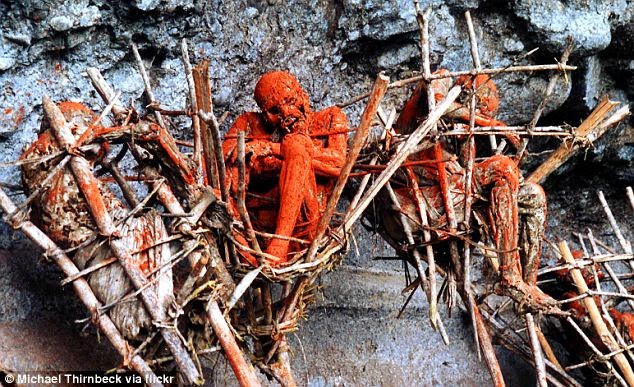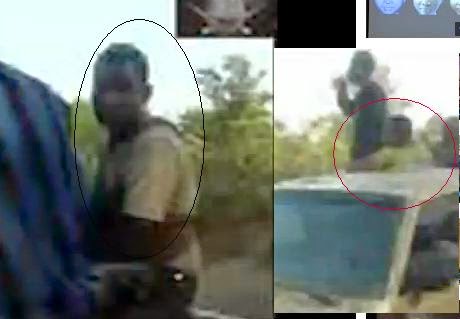SEE How Tribe pays respect to the dead by curing them and hanging them above their village to look over them
From the cliffs of a village in Papua New Guinea's Morobe highlands, charred corpses leer at passers-by.
Their flesh is stained red, and they seem to be imprisoned within cages of bamboo, as if to keep them from leaping down and devouring any explorer who strays too close.
But this macabre practise is not (only) a way to scare away strangers. For the Anga people in these remote parts of the country, it is the highest honour they can bestow on their dead.
Dead men, women and children are effectively smoke cured, in much the same way as a kipper.
Their flesh is stained red, and they seem to be imprisoned within cages of bamboo, as if to keep them in
But this macabre practise is not (only) a way to scare away strangers. For the Anga people in these remote parts of the country, it is the highest honour they can bestow on their dead
First, experienced embalmers make cuts in the feet, knees and elbows of the cadavers, to allow body fat to drain away, before jabbing bamboo poles into their guts and collecting the drippings.
These are smeared onto the skin and hair of surviving relatives in a ritual believed to transfer the strength of the dead into the living. Any leftovers are used as cooking oil, for the same reason
They then sew shut the eyes, mouth and anus of the body they're working on, to reduce the air intake in an attempt to prevent flesh from rotting.
Dead men, women and children are effectively smoke cured, in much the same way as a kipper
First, experienced embalmers make cuts in the feet, knees and elbows of the cadavers, to allow body fat to drain away, before jabbing bamboo poles into their guts and collecting the drippings
The drippings smeared onto the skin and hair of surviving relatives in a ritual believed to transfer the strength of the dead into the living. Any leftovers are used as cooking oil, for the same reason
They then sew shut the eyes, mouth and anus of the body their working on, to reduce the air intake in an attempt to prevent flesh from rotting, the they cut off certain soft parts before curing them in a smoke pit
A Papuan man looks at the cliff-side watchers who are believed to be the guardians of the village
The soles of the feet, palms of the hands and tongue are sliced off and presented to the surviving spouse and then what's left of the body is smoke cured over a fire pit, before being coated in clay and ochre to deter scavengers.
The cliffs of the Morobe highlands are littered with these corpses, some dating back 200 years of more.
They are sometimes brought down for special events and celebrations, and returned soon after.
A family carries a mummy back to the cave above the village after carrying out essential restoration work
The practise is frowned upon by the Catholic church and has been banned since 1975
These watchers are believed to be the guardians of the village. The most-respected warriors are placed on special lookout points on the cliffs, watching out for invaders.
The practise is frowned upon by the Catholic church and has been banned since 1975, when PNG gained its independence.
But in remote parts, where even today few missionaries dare to tread, a few tribes still prefer to mummify their dead - perhaps to keep the priests away.





Comments
Post a Comment